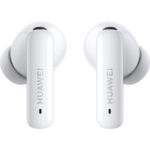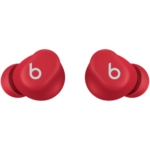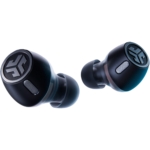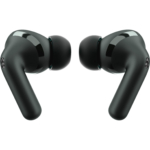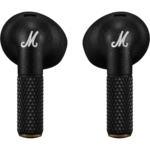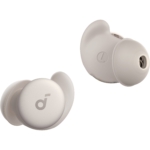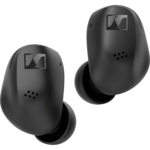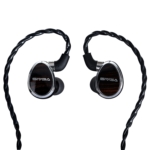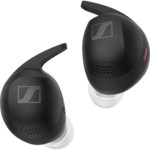The Samsung Galaxy Buds2 Pro are the tech giant’s best True Wireless in-ears to date. They offer great wearing comfort and good basic sound, which can also be adjusted (to a limited extent) to suit your own needs via EQ pre-sets. The noise cancelling also does its job well, but does not cancel out noise as broadly as models from the competition Apple, Bose or Sony. The range of functions is almost unmanageable but can only be used meaningfully if the external players come from the same company and support at least Android One UI Version 4.x. If your devices come from the Samsung universe, the Samsung Galaxy Buds2 Pro is an ideal everyday accessory.
- Good sound with slight weaknesses
- Wide range of functions
- Lightweight and small form factor
- No real multipoint
- reduced range of functions if no Samsung terminals are used
Comfortable to wear, with effective noise cancelling and good sound. Samsung’s latest True Wireless flagship Galaxy Buds2 Pro can do a lot and perform astonishingly well. However, to enjoy the full range of features, you will need special Samsung peripherals.
Package and wearing comfort
The Samsung Galaxy Buds2 Pro, available in the three colours “Graphite”, “Borapurple”, and “White”, only weigh around 5.5 grams per earpiece. Their design will suit those who like to wear caps or lie in bed with headphones on because these in-ears are very small and fit almost flat in the ears.
With the smaller Samsung Galaxy Buds2 model, we criticised the smooth plastic of the earpieces. Here, it’s different: the surface of the Samsung Galaxy Buds2 Pro seems slightly rubberised and rough so that even those with larger hands/fingers should have no problem holding them firmly and securely. At any rate, we did not experience any accidental slipping of the fingers with the model we tested.
This model’s matching charging case also creates an impression of sturdiness. With its 43 grams, it disappears imperceptibly into your pocket, but the case’s magnets do not always ensure that the in-ears have snapped securely into place to be charged. Every now and then, we had to move the earpieces a few millimetres to ensure charging contact.
There are also three pairs of silicone earpieces in different sizes as well as a USB-C to -A charging cable in the package.
The in-ears themselves have an IPX7 certification and can thus theoretically be used for up to 30 minutes under water up to one metre deep. However, it must be mentioned that these in-ears must always be dry when placed in the charging case; otherwise, the kit could be damaged. The case itself does not have an IPX rating, so it should, therefore, always be protected from moisture and dust.
Bluetooth & Pairing the Galaxy Buds2 Pro
The Samsung Galaxy Buds2 Pro offer the current Bluetooth version 5.3, and the codecs SBC, AAC and the manufacturer’s Hi-Res variant, “Samsung Seamless Codec”, are available. The latter offers a resolution of 24-bit and 48 kHz; however, this is reserved for Samsung Galaxy Devices that work with One UI version 4.0 or higher. On top of this, the 24-bit mode may first have to be selected in the developer settings of your smartphone or tablet. It seems that here non-Samsung users are left out in the cold because other Android phones, along with Apple devices, do not support this codec. In both cases, AAC or SBC would then be used.
The Samsung Galaxy Buds2 Pro is not capable of true multipoint, i.e. simultaneous connection with several end devices. Although the manufacturer mentions an Auto Switch function, it actually works in a similar way to the Apple AirPods Pro 2: Auto Switch is only available on Samsung Galaxy smartphones and tablets with OneUI 4.1 or higher and the Galaxy Watch 4 series or higher. All Galaxy devices must be connected to the same Samsung account for the whole thing to work. The same goes for Samsung TVs. All Samsung TVs that came onto the market in February 2022 or later and have received a firmware update from July 2022 support Auto Switch – but this only applies to phone calls. In other words, if you receive a call while watching TV, the headphones automatically switch to your smartphone – and then back to the Samsung Smart TV after the call without any further action.
Pairing the Samsung Galaxy Buds 2 Pro is quick and uncomplicated; a status LED inside the case informs you about the status. For Samsung devices, simply open the charging case to start the pairing process. The wireless hook up then just needs to be confirmed via a pop-up window. For non-Samsung smartphones, pairing must be initiated manually. Once done, the Samsung Galaxy Buds2 Pro will pair with the same device automatically as soon as the case is opened and the in-ears are inserted into your ears.
How long do the Samsung Galaxy Buds2 Pro last?
The Samsung Galaxy Buds2 Pro are not long-lasting, but if you’re specifically looking for True Wireless in-ears that have staying (battery) power, then you should take a closer look at the Creative Outlier Pro. These headphones run for a whopping 14.5 hours with ANC, while the Galaxy Buds2 Pro have just under five hours with the volume turned up and active noise cancellation in use.
The charging case can supply these small earbuds with power for up to another 18 hours. The case can be recharged via USB-C, wireless Qi charging mat or PowerShare, and there’s also a fast-charging function.
How to control the Samsung Galaxy Buds2 Pro
The Samsung Galaxy Buds2 Pro are controlled via touch commands. The manufacturer seems to have remedied the over-sensitivity of its predecessors. These headphones usually responded reliably to finger taps and emitted a soft sound at the same time for added certainty. In our test, it was noticeable that the headphones didn’t react to touch commands after a longer period of use, as if these small in-ears were in a kind of “standby mode” or in deep sleep. The only solution is to disconnect them and reconnect them to the phone. Samsung should urgently fix this with a firmware update because what are touch-sensitive surfaces for if they do not work?
If you would like to create their own control logic, e.g. because you own several pairs of headphones and would like to control them with the same gestures, then I’m afraid you will be disappointed. Like with the smaller Samsung Galaxy Buds2, the configuration possibilities are limited. Free gesture assignments cannot be implemented, so controls can only be completely activated or deactivated or individual touch functions can be activated or deactivated.
In practice, this means that if you want to control the ANC on the left and change the volume on the right, you cannot do so. The app adjusts the corresponding headphone side in accordance with the function selected.
Tap and Hold activates the manufacturer’s voice assistant on Samsung devices; this can also be done by voice (“Hello Bixby”). If you don’t need this, then you can simply use the same gesture as a Spotify command. Once activated, the headphones play the content from exactly where it was previously paused. Of course, these headphones also offer other comfort options: if you like, you can set the Samsung Galaxy Buds2 Pro to read out notifications. In addition, there is the so-called “active conversation mode”, which can be quite valuable because the headphones can simply remain in your ears while you start talking, noise cancellation is automatically switched off, and the voice of the other person is amplified. But the Samsung Galaxy Buds2 Pro has also taken into account those of us who are working from home; thanks to the detection and reminder function, the headphones alert you to stretch your neck to avoid bad posture.
As with the Samsung Galaxy Buds2, we also found the extremely practical “Auto Pause” feature on this model. And once again – to put it mildly – we found that it “takes some getting used to” because media content is only paused when both earbuds are removed. If only one in-ear is “pulled”, the music continues to play. The fact is, these headphones do not automatically continue playback after insertion in your ears; instead, the play button has to be pressed first, and we found this to be unworkable and too cumbersome.
Galaxy Wearables App
Of course, an app is needed to make the aforementioned changes to the controls. Annoyingly, the Galaxy Wearables App demands a lot of access permissions when it is started for the first time and simply refuses to work if you do not allow at least one of them.
After the appropriate permissions have been granted, the Samsung Galaxy Wearables app not only displays the remaining battery life of the in-ears and the case, but the listening modes can also be controlled, home screen widgets can be created, or you can complete a fit test. You can change the sound of the Galaxy Buds2 Pro using the equaliser, but there are only five pre-sets available (“Bass Boost”, “Soft”, “Dynamic”, “Clear”, and “Treble Boost”). It is not possible to create your own sound curve.
If you have a slight hearing impairment, then you will be pleased to find out that there is even a possibility to change the balance, i.e. the volume differences between the right and left channels, via a slider.
Added to this is a headphone finding function called “SmartThings Find”, which displays the headphones on a map, as well as the option to be notified when you move away from the headphones with your smartphone.
Apple users are left empty-handed, as there is no app for iOS, so the Samsung Galaxy Buds2 have a very limited life in the Apple universe because nothing can be adapted. If you want to adjust anything, you have to connect an Android device in between.
The sound of the Samsung Galaxy Buds2 Pro
A team of AKG acousticians gave this model a modern sound that is particularly pleasing when listening to current chart music. Nevertheless, when we turned up the headphones and listened to our test tracks, the Samsung Galaxy Buds2 Pro revealed slight weaknesses. For example, the mid-range built a little too inconspicuously on the boosted bass range for our taste, and with fat sub-basses, some details were lost. The treble range tended to go overboard, especially in the appropriate tracks. On Madonna’s “Jump” or tracks with especially sharp hi-hats, the sharpness was unmistakable. If you want to counteract this with an equaliser, you will, of course, have a problem because the five pre-set curves simply don’t allow it.
Overall, however, the Samsung Galaxy Buds2 Pro delivered a thoroughly pleasing sound experience that will certainly satisfy most people for everyday commuting or for use in the home office.
The aforementioned 24-bit mode, which is only available to certain Samsung mobile phone owners, feels a little “special” when it comes to practical use. If you only ever stream compressed music from Spotify and the like, there is no benefit, as we could not detect any differences in sound. Local or streamed HiRes files do, of course, benefit from the upgraded Samsung codec, which makes music sound fresher, more open and more detailed. Here, however, the headphones’ own sound signature as mentioned above and the limitations of the equaliser function get in the way – the Samsung Galaxy Buds2 Pro are not audiophile connoisseurs.
It should be mentioned that these earbuds can also handle surround sound. Of course, this 360-degree sound requires corresponding 5.1, 7.1 and Dolby Atmos content. Thanks to dynamic head tracking, the sound source remains fixed so that you move your head relative to it. However, personal taste is always the deciding factor with such things. For many, this is perhaps only a gimmick because real surround also requires the corresponding number of speakers, which no headphones – not even the Samsung Galaxy Buds2 Pro with their two-way drivers – are able to implement this in the way we would recognise it from (home) cinema.
How well do the ANC and transparency mode of the Galaxy Buds2 Pro work?
The active, single-stage noise cancelling of the Samsung Galaxy Buds2 Pro works effectively – but not across the entire frequency range. The three microphones installed on each side filter out low frequencies so that there was silence “down below” when travelling by bus or train. Voices and high-frequency material were muffled, and the background noise was perceptible, but it diminished almost inaudibly as soon as music was playing. A slight change in sound was also noticeable: When noise cancelling was activated, the bass range had a little more pressure and seemed more compressed.
The Samsung Galaxy Buds2 Pro don’t have quite as good a grip on wind, however: while light breezes were no problem, the active circuit struggled to properly suppress airflow when used while riding a bicycle.
The transparency mode was also usable: While it lacks the naturalness offered by the Apple AirPods Pro 2, conversations could be followed without any problems. When it comes to ANC and transparency mode, competitors Apple with their AirPods Pro 2 and the Bose QuietComfort Earbuds II are still ahead.
How well can you make calls with the Samsung Galaxy Buds2 Pro?
Unfortunately, crystal-clear phone calls cannot be made with the Samsung Galaxy Buds2 Pro in noisy environments. The built-in technology had trouble filtering out unwanted background noise properly, and distortions occurred time and again. However, these in-ears left a good impression in a quiet home office environment during video calls.
Technical specifications
- Ear couplingIn-ear
- Typeclosed
- Transducer principledynamic
- Weight without cable5,5 g each, case: 43 g g
What's in the box
- Silicone ear tips (S, M, L)
- USB charging cable
- Charging case
Special features
- Available in Graphite, Borapurple and White
- BT codecs: SBC, AAC, SSC
- BT version: 5.3
- BT profiles: A2DP, AVRCP, HFP












